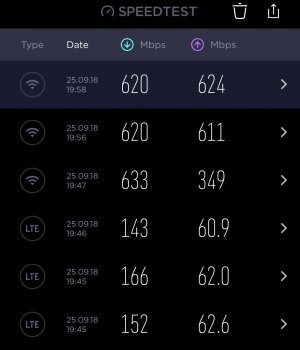Okay guys... I took my Pixel 2 into the office today to get a little bit more data. This is what I have come up with:
It seems like some are having issues after restoring a backup when they set up their new phone. That is probably unrelated to what I am about to type and what I provided in the quoted post. I set my iPhone up as new since I am coming from a Pixel 2.
I am ONLY talking about actual RF performance - not speeds. I am dealing with raw data on Verizon. Everyone's experience will be different depending on carrier and active LTE band. Each LTE band can and will have their own performance to a certain degree.
So what I have found besides the quoted post above?
My Verizon LTE connection in terms of pure coverage is actually relatively close to my Pixel 2. No LTE drops on my commute... Only during the brief elevator ride did it drop, but then it immediately regained LTE within 5-10 seconds once I got off of the elevator.
Now lets get to the actual issue (if there is one):
For Verizon's Band 4 (AWS), my Max is averaging about 7dBm worse than my Pixel 2 - granted my Pixel 2 was pretty good on that band. I had a Pixel 2 XL briefly and the smaller Pixel 2 beat it on average by 3-4 dBm. So the iPhone isn't AWFUL. But not exactly great in that band.
For Verizon's Band 2 (PCS), my Max is averaging actually relatively close to my Pixel 2. I would definitely say within the margin of error - maybe 2-3 dBm on average worse. Nothing too bad.
For Verizon's Band 13 (700MHz), my Max is also averaging about 2-3 dBm worse than the Pixel 2 - so again within what I believe would be the margin of error.
So what does this all mean? Well each carrier is different... Each band is different. In terms of what it means for me (or probably most Verizon users), is that coverage wise it should be pretty similar. The problem is in areas that are congested and/or fringe AWS/PCS areas. I have areas that I used to be on AWS B4 (with CA on B13), but I am now only on B13. That means less throughput/spectrum available to me which = less speed... Also it means most likely more users on B13 only seeing as iPhones are extremely popular which = less speed. I would expect that is these fringe areas that speeds may plummet.
What about those that seem to get a good connection for awhile after Airplane mode or resetting Network Settings? Well this can also be explained. When you initially connect to a cellular network it has a tendency to pick the strongest connection (B13 for Verizon). After anywhere from about 30 seconds to a few minutes, the network will try to dump you off to a higher frequency (B4 in my case). That's all good and all, but these iPhones don't seem to have good RF performance in that band.. Which causes the lower signal quality and may be leading to some of your issues.
"Oh - but I am not having issues - this can't be true!!" - Oh but it can be true. Everyone will have different experiences at different cell sites and different times of the day. Each network tries to manage users and offload them onto other bands to free up capacity, etc. If you now have connection to only the main coverage band (B13 on Verizon, B12 on T-Mo, B12/B17 on AT&T) then your throughput will be reduced. HOWEVER, if you are in an area with overall great coverage and cell spacing then you may never experience this.
Long winded response from me on this. Take this as you will. Most will probably ignore it or call it fake news. I don't care. I have been playing around with phones and comparing RF performance on them for years (started back when I was with Sprint because of their swiss-cheese network - had to get the phone with the best RF performance then, ha!). Take the data and manipulate it as you wish.



